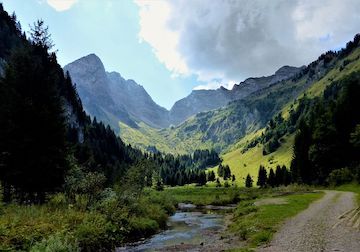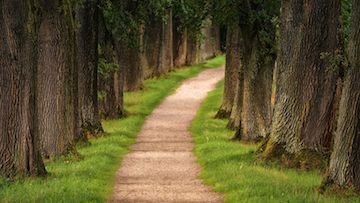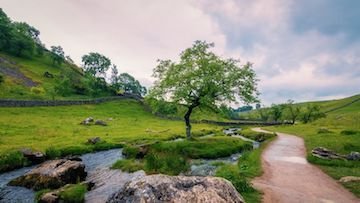The Ten Stages of the Mahayana Bodhisattva Path
The Seventh Stage
Part 9

Introduction
Stages of the Mahayana Bodhisattva Path are similar to the Theravada idea of the Noble Eight-fold Path, although not the same in the order of the stages, as well as the aim of the various stages that comprise the total trajectory that the Bodhisattva has to traverse. The idea of the Bodhisattva path is linked to the idea of bodhicitta, the aspiration of becoming enlightened, and this aim is for the benefit of all sentient beings—when compared to the Arahant idea it is distinguished by the fact, that the Bodhisattva holds off on attaining final non-returning Nirvana until all sentient beings are brought along the journey of the Bodhisattva path towards Enlightenment.
Mahayana Texts
Various Mahayana texts discuss the stages of the path in varying detail and order. For this ninth article in the series, I’ve mainly followed the stages of the Path as explained in the Dasa Bhumika Sutra. Dasa bhumika in Sanskrit means ten stages.
In the Dasa Bhumika Sutra, a Bodhisattva is compared to gold in each stage, which is purified more and more by being heated in the goldsmith's fire until it is at last made into an ornament to be worn around the neck of a powerful wheel-turning monarch (cakravartin). The bodhisattva's splendor is likened to the light of the moon and the sun. In each subsequent stage, a Bodhisattva's glory and power (prabhava) increase a hundred-fold, a thousand-fold, a million-fold, and so on.
I’ve also consulted the abhidharma-samuccaya text of Asanga, the prajna-paramita abhi-samaya-lankara, the Mahavastu, and the Mahayana-sutralamkara text. The Avatamsaka Sutra (Flower Ornament Scripture) has great details on the 10 stages of the path as well, including the Gandavyuha commentary. For cross-reference purposes I’ve used the yogacarabhumi text, which incorporates the bodhisattva stages into an even greater 17 stages, to verify Sanskrit terminology.

In this article, I’ll cover the seventh stage of the 10 Stages of the Mahayana Bodhisattva Path.
The Bodhisattva’s practice to be Unestablished in either Samsara or Nirvana.
Subhuti: The perfection of wisdom of the Bodhisattvas, the great beings, O Buddha, is not grasped at on the shore this side [of samsara], or on the shore beyond [of nirvana], or in between the two.
The Buddha: Because of its absolute purity, Subhuti.
Subhuti: For what reason is the perfection of wisdom of the Bodhisattvas, the great beings, not grasped at on the shore this side [of samsara], or on the shore beyond [of nirvana], or in between the two?
The Buddha: Because of its absolute purity, Subhuti, on account of the fact that all dharmas are the same in the three periods of time.

Summary
Stage 7. The Going Far stage (duramgama bhumi)
The seventh stage is considered Going Far, as the Bodhisattva works on developing many aspects on the path: attainment of great compassion (karuna) for all sentient beings, full understanding of the five aggregates of the body and mind (skandha), great development of the aspiration for Enlightenment (bodhicitta), excellence in the perfection of energy, and the ability to convince non-Mahayana followers to switch to the Mahayana path through skillful and expedient means (upaya-kausalya paramita) and lead them onwards to Enlightenment.
In detail
The seventh stage is called durangama, because in this stage the Bodhisattva reaches the end of the practice by means of the single path (ekayana-patha). This stage is considered the stage that is devoid of signs (animittacari).
Various types / levels of ignorance have been purified in the first six stages, and in each subsequent stage the ignorance that is to be purified is more subtle and difficult to address than in the previous stage.

A Bodhisattva, after completing the bodhisattva-path of the first six stages, now enters into the seventh stage. He starts practicing a different and superior part aided by the ten kinds of knowledge of skillful means (upaya-prajna). There are two parts to each of the ten kinds of knowledge or activities of the bodhisattva, the first part being the actual skillful means, and the second being the skillful means adopted by him for the sake of ordinary sentient beings.
The ten types of skillful means are as follows, the Bodhisattva:

Practitioners in the seventh stage are proficient in concentration on emptiness, wishlessness, and signlessness; enter into selflessness and transcend ideas of personality; yet still accumulate virtue and knowledge and do not give up practicing infinite kindness, compassion, joy, and equanimity. They detach from the world yet work to beautify the world; whereas practitioners arrive at extinction in the sixth stage, in the seventh stage they plunge into extinction and emerge from it in each mental instant, without being overcome by extinction. They live in the world by will-power for the sake of others, without being stained by the ills of the world; they become calm and serene, yet they can be passionate as an expedient without, however, becoming inflamed by passion.
Furthermore, in the seventh stage, twenty dharmas do not manifest in the mind of a Bodhisattva:
A Bodhisattva does not depend on [identify with]:

A Bodhisattva does not settle down in [identify with]:

A Bodhisattva does not take refuge in [the view of]:

A Bodhisattva has:

The Mahayana-sutralankara explains that this stage is so called because it leads to the end of the only Way, to the consummation of the discipline. A Bodhisattva now acquires great wisdom in the choice of skillful means for helping others. He understands that all the Buddhas are of the same nature with their spiritual dharma body (dharmakaya). He participates in the infinite attributes of the Buddhas, and sees their multifarious physical bodies. He discerns the thoughts and feelings of others. He practices all the ten perfections every moment. This stage witnesses the complete fulfillment of the practical aspects of a bodhisattva's discipline, and now he begins to attach more importance to its meditative and metaphysical aspects. He has conquered all the passions and sins and is free from them. His thoughts, words and deeds are pure, and he is in possession of all the factors of Enlightenment. His work is effortless and without ulterior motive. He transcends the lower wisdom of the Non-Mahayana path. He attains emancipation, but does not realize [holds off on] personal nirvana. He enters the great ocean of Buddha-knowledge.
In the next article, I’ll be discussing The Eighth Stage of the Mahayana Bodhisattva Path in full detail.

References for research:

I will flag comment spam at 1% strength. If you keep on spamming my post, I will flag you at 100%. I don't care if you have limited English abilities, write a couple of sentences about this article, no copy-paste, please. I will flag: one sentence comments, links to your blog and begging for up-votes and follows. Also, I will flag comments that have nothing to do with my blog's article. I will also check your comment section to see if you have been comment spamming on other blogs.


 A link to My Blog
A link to My Blog
@reddust, You recovered those Mahayana Bodhisattva Path very speedy. Well introducing seventh one here and totally inspiration to understand everyone. Duramgama bhumi wanna another Bodisattva stage of devoid of signs as you mentioned. Bodhisattva passed those ten stages and then told & Preached to Buddha's followers. Currently we have got massive lessons via followed Buddha's character. In fact your blogs totally high value coz introducing Bodhisaththva character to the steem blockchain.
My first meditation and teachings were from the Pali Canon, given to me by a Mahayana teacher, I also took the Bodhisattva vow from my Korean Zen teacher and so I studied the Prajnaparamita @madushanka, I fell in love with the Bodhisattva path...
It is a pleasure sharing what I learned from my teacher!
You have covered so much in this post. My comment is directed to what impressed me the most. This is the 10th( a and b) skillful means. The fact that understanding that present, past and future are only one moment. I cannot say I have comprehended it, however, I see how considering it will make you understand better eternity. Time, instead of being linear, it becomes a single point. Everything that happened, happens or will happen is contained in that dimensionless point.
What I learned when I first started study is read through the text, write down what I don't understand and ask my teacher to clearify, I am a country girl from the State of Oregon, a hillbilly, I know I knew nothing about anything dealing with Buddhism, I was raised in a Christian community and a simple person...hahaha
After hitting some strong Samadhi at retreat where time disapeared so sitting was effortless, I also become fascinated with time...I think time is a figment of our imagination @marcusantoniu26 ;-)
We are all simple. I am a South American who ended in Michigan. I still do not know much about Buddhism, what I know is what I have read in your posts. I find it extremely deep and a means to achieve a selfless, giving existence.
Jesus and a Buddha differ in many ways but one of the significant differences is Buddha does not depend on a God or any supernatural being to save his soul, there is no soul in Buddhism. we have the potential to become enlightened, called Buddha Nature.
Buddha was a human being and Jesus was the Son of God both taught peace and compassion for others, to live a selfless life was the best way to live one's life.
The only way to know the Christian God is through Jesus Christ.
Through Buddha's realization and insight he finds the path out of self-caused suffering and freedom from the rounds of rebirth. Through his compassion and wisdom, he does not leave this worldly plain, which the Buddhist cosmology call the desire realm and teaches us, unruly humans, how to escape our self-made prison.
Buddha taught the Gods because they too eventually are reborn into the human realm and go through the crap we have to go through. Good karma doesn't last forever so one must let all their karma go. Old Karma is our body, our actions create who we will become in our next life. Karma is called the Law of Nature/cause and effect. What you do, the actions you take is like energy and this energy does not stop when we die.
Buddha didn't make any laws. The Ten Commandments are Gods law and to break them is a major sin, the soul will end up in hell forever. Even though Heaven is forever as well...how can two absolutes exist? I asked my Bible study teacher when I was a teenager about this paradox and he couldn't give me an answer.
There is no eternity or nihilism In Buddhism, and there are many kinds of hell realms or heavens we can take rebirth in but they do not last forever, we can break free of them any time through letting go of our conditioning, they are all caused by one's own positive or negative mind states and actions. One can only save oneself from self-created negativity. There is no God that has the power to clean up a messy mind, just beings who have the ability of self-knowing have that kind of power
Being angry, greedy, hateful are hellish mind-states we can experience right now! Buddha also taught we could experience real freedom in this lifetime as well, we do not have to die and go to heaven to experience freedom from negative mind states and actions that cause us endless suffering and rebirths.
The practice would help you see your god as he truly is not just his name and your conditioned belief. I’ve meditated at vipassana retreats with catholic nuns, I think Jesus taught men how to fish, he knew giving them fish wouldn’t be helpful🙏
I’m not out to recruit New Bodhisattvas lololol (hugs) @amigoponc
All I have for the religion is enthusiasm, no opportunity to become one, over here in Nigeria, is there no book I can purchase written I English that can get me started. All together you are taking your time to do some very good work, it's lovely.
There are a ton of books and sites online you can study the Bodhisattva way and lots of youtube presentations as well...
Thanks for the aid
The most I like teaching that is Suffering come from passions.
I suffered from a really bad temper and learning how to meditate correctly, being able to see clearly what triggered my temper helped me let it go...raging anger is just like hell and so are passions. But it is easy to see strong mind states and they make good meditation tools to break free from old conditioning. It sucks when habits and triggers get subtle, it's harder to see and let go. That's where I am right now....sigh
When we just want to be of help and give of ourselves without asking for anything, we're practicing the way of bodhisattva, the key to gaining the happiness of liberation.
There is wise compassion, that is the way of the Bodhisattva. For me most of my help causes more problems, I am not that wise. An example I clean up my grandchildren's bedrooms because they are always a mess.
What I should do is teach my grandchildren how to clean up their rooms and keep them clean. That is difficult because you have to be there with them and make sure they do their chore. Many times they get mad at me because of this....hahaha
No rewards for doing a chore, just a hug and telling them, "Well done!"
I've been following the series and enjoying your writing reading it.
It helps us understand life and our life's purpose.
Thanks for sharing this post with us and wishing you an great day. Stay blessed. 🙂
How does this article help you understand life and life
s purpose @anouar8?
At least if it teaches you how to have a happier life, through wisdom in the face of the adversities of life. @reddust
This is very deep and a lot of work. Interesting read as always. Thank you!
You are welcome @violinist, my pleasure, what was the deepist part for you?
take care every moments.
Luvly blog. Brilliant job.